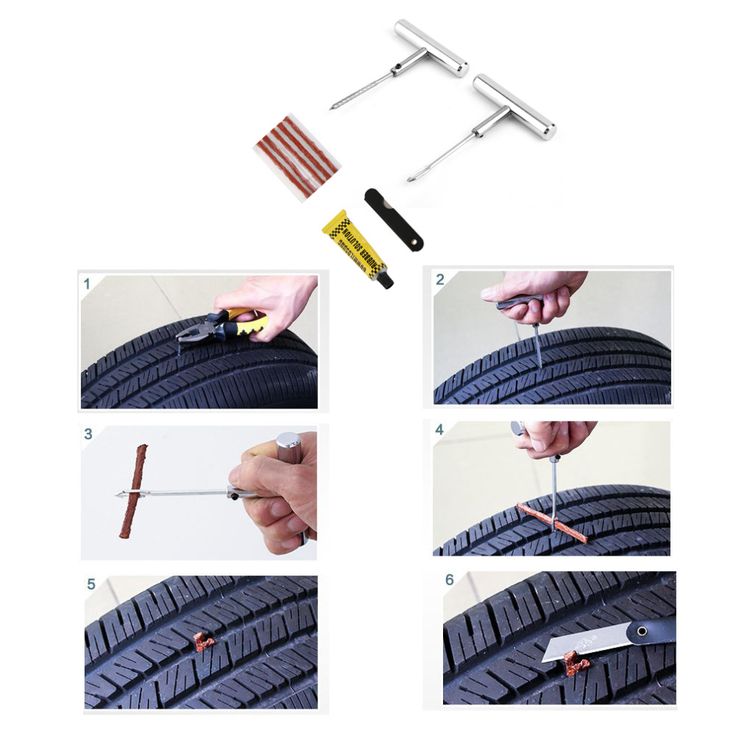Posted by Jefferson Bryant Know How
Flat tires tend to happen at the worst time in the worst places. If you are on the road or outside of normal business hours when your vehicle has a flat and the spare is missing or no good, you might feel stranded, but there is an option—a tire plug kit. This is something that anybody can do, you just need the right parts.
Liquid tire repair might get you down the road, but it could make your tire repair difficult and possibly damage the TPMS (Tire Pressure Monitor System) unit inside the rim itself depending on the formula. The best solution for an emergency tire repair is a tire plug. Made from cork and a gooey adhesive that keeps it place and seals the tire, a tire plug repair is an excellent way to get your car back on the road until you can get to a tire shop for a proper internal patch.
Installing a plug in your tire works for pierced tread area only. You cannot fix sidewall damage, compression breaks (from potholes, gravel roads or curbing) or any other type of catastrophic tire damage. The most common road hazards you will find are punctures from nails and screws. Fixing these issues are perfect for the good old fashioned tire plug. If you are wondering how long does it take to plug a tire, then the answer is just a few minutes. Most of the time is spent preparing to perform the plug itself. Here’s how to plug a tire with a plug kit.
You will need the following to make a tire plug repair:
There are all kinds of tire plugging kits, but you want the most complete tire repair kit which comes with the plugs, the installation tool, and the reamer tool.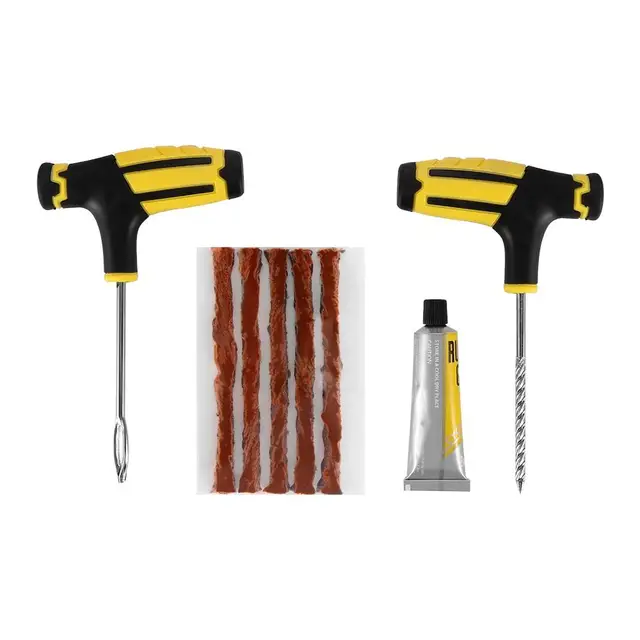 Some flat tire repair kits just come with the plugs and installer, but the reamer tool is a necessary component to a good repair. Some tire plugging kits also come with liquid cement. You can use it or not, but the cement helps make a more permanent repair.
Some flat tire repair kits just come with the plugs and installer, but the reamer tool is a necessary component to a good repair. Some tire plugging kits also come with liquid cement. You can use it or not, but the cement helps make a more permanent repair.
Locate the puncture. If you don’t see or hear the puncture, spray some soapy water on the tire and look for bubbles.
This is a small staple that was dropping tire pressure by 20 psi in about 12 hours. It needs to go.Remove the offending item. This is usually easy, but sometimes the nail or screw is worn down, making it hard to get a bite on it. This is where the side-cutters come in really handy. You will want to position the tire where you get the most leverage.
Side cutters work best for removing these items, as they can grip small round objects better than regular pliers.Insert the reamer.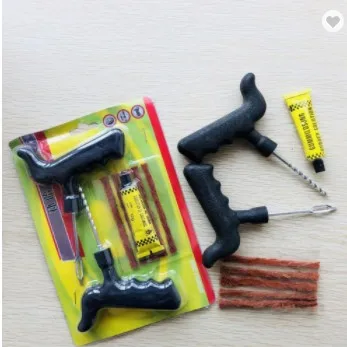 This will take some effort, as you have to push it through the steel belts. Use a twisting motion and push it into the tire. Once the reamer is through, saw it in and out of the tire a few times to really make a nice hole for the plug. Yes, it is counter-intuitive, but it is necessary.
This will take some effort, as you have to push it through the steel belts. Use a twisting motion and push it into the tire. Once the reamer is through, saw it in and out of the tire a few times to really make a nice hole for the plug. Yes, it is counter-intuitive, but it is necessary.
Push the reamer all the way and then saw it in and out a few times to make a clean hole.
Prep the plug and installer. Pull a plug off the strip and push it through the eyelet of the installer tool. The pliers will make this easier. Push a little through, grab it with the pliers and pull the plug halfway through the eyelet.
Pull a cork strip from the tire plugging kit and grab the installer tool, which looks like a large needle with a slit in the eye.Threading the sticky cork tire repair plug is not easy, but if you can get it squished into the hole, you should be able to pull it on through.
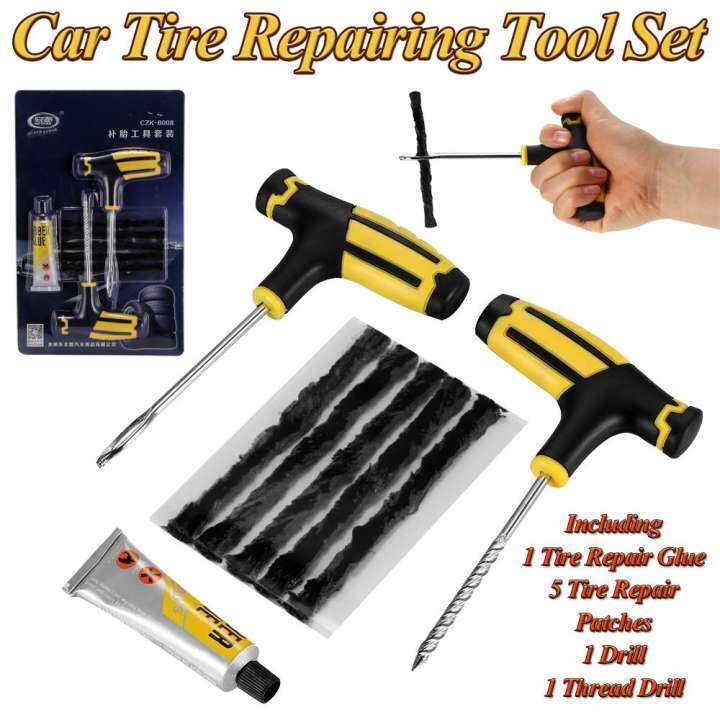 The side cutters might help.
The side cutters might help.Insert the plug into the tire. If the kit has liquid cement, apply some to the plug before inserting it into the tire. Simply push the installer into the hole in the tire until the plug is about 3/4 of the way in. Twist the installer tool 90-degrees and pull it out. The plug will stay in the tire and the tool will come out nice and easy. You may trim away the excess plug or leave it to wear away as you drive.
Push the tire plug into the hole. Don’t twist the plug as you push it in, just go straight down and stop when there is about a 1/2-inch exposed.This is what you should see when the tire plug is installed.
Once the tire repair plug is in you can now twist the handle 90-degrees and pull the tool out.
Fill the tire to the proper PSI. If you have a portable air compressor, this will make things easy. However, if you do not, you need to get air very soon.
All done.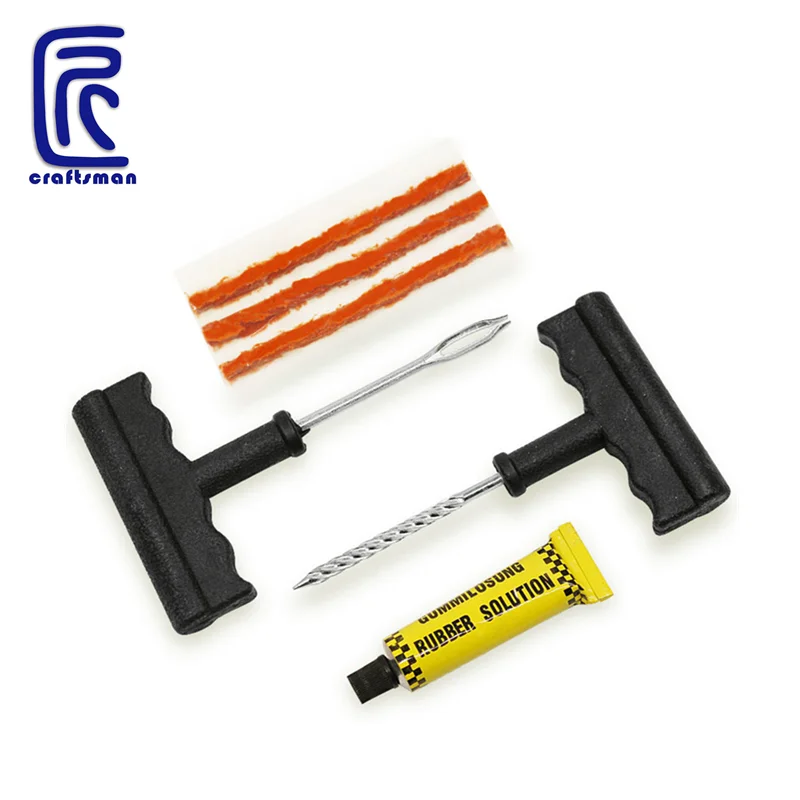 You can trim the tire plug or leave. You will need air, so don’t go driving until you have the tire aired up.
You can trim the tire plug or leave. You will need air, so don’t go driving until you have the tire aired up.Every automobile you own should have an emergency tire plug repair kit in the tool box, along with a portable air compressor. These emergency repairs are quite good, but for a long term repair, you should take the vehicle to a tire shop for a proper repair as soon as possible. They will know the best way to patch a tire for your type of damage.
Check out all the steering & suspension parts
Categories
Know How
Tags
emergency repair, flat tire, flat tire repair, patch flat tires, sealant, tire maintenance, tire plug kit, tire pressure, tire safety, tire wear, tires, wheels
A life-long gearhead, Jefferson Bryant spends more time in the shop than anywhere else. His career began in the car audio industry as a shop manager, eventually working his way into a position at Rockford Fosgate as a product designer. In 2003, he began writing tech articles for magazines, and has been working as an automotive journalist ever since. His work has been featured in Car Craft, Hot Rod, Rod & Custom, Truckin’, Mopar Muscle, and many more. Jefferson has also written 4 books and produced countless videos. Jefferson operates Red Dirt Rodz, his personal garage studio, where all of his magazine articles and tech videos are produced.
His career began in the car audio industry as a shop manager, eventually working his way into a position at Rockford Fosgate as a product designer. In 2003, he began writing tech articles for magazines, and has been working as an automotive journalist ever since. His work has been featured in Car Craft, Hot Rod, Rod & Custom, Truckin’, Mopar Muscle, and many more. Jefferson has also written 4 books and produced countless videos. Jefferson operates Red Dirt Rodz, his personal garage studio, where all of his magazine articles and tech videos are produced.
Despite eight figure verdicts and public safety campaigns by the National Highway Traffic Safety Administration (NHTSA) highlighting the dangers of improper tire repairs, (“plug-only” and “patch-only”) repairs, suppliers continue to market and sell plug-only repairs kits. Likewise, tire repair shops continue to use these improper repair methods.
This web page discuss tire repair techniques, the relative safety of those various repair methods, tire repair litigation and some of the reasons these unsafe methods persist.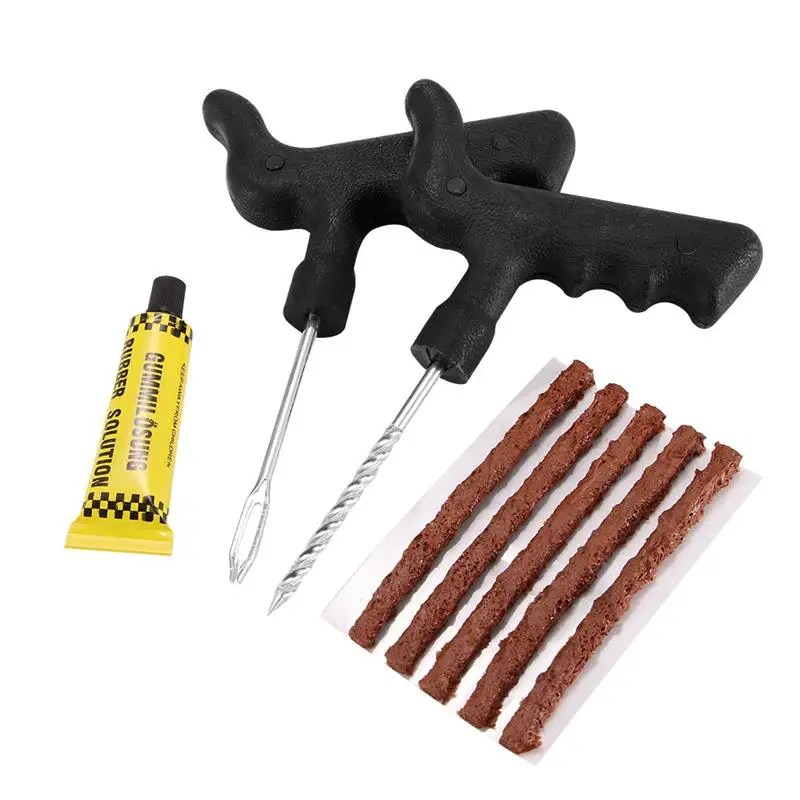
Safe and Unsafe Ways to Repair a Tire
Most people discover that their in-service tire may have a puncture after noticing that their tire is flat or low on air.
There are three common ways to repair a punctured tire: A plug-only, a patch-only repair or a combination repair. The patch-only and combination repairs require the technician to demount the tire from the rim to examine the inside of the tire for damage and repair it from the inside. The plug-only repair does not. When tire rubber has been punctured, the hole tends to close up when the puncturing item us removed. Therefore, unless there has been damage or the puncturing object is still protruding from the tire, it can be difficult to locate the puncture through a visual examination only.
Technicians will often swab the tire with soapy water or dunk it into a tank to look for bubbles of escaping air. It is impossible to inspect the cavity of the tire for any puncture damage without removing the tire from the rim. This is one of the multitudes of reasons why a plug-only repair is an unsafe method.
This is one of the multitudes of reasons why a plug-only repair is an unsafe method.
A plug-only repair is accomplished by inserting the plug through the outside of the tire with an insertion tool. The insertion tool is the removed, leaving the plug in the hole, and thereby filling it. Often times, this plug-only repair is a “string plug,” which consists of a 4 to 5 inch long woven cord that is covered with a tacky substance. String plugs are typically supplied as part of a repair kit consisting of a reaming tool, an insertion tool and a few string plugs. Some kits also contain rubber cement to help create a seal between the string plug and tire. The cost of a string plug repair kit ranges from $4.00 to $5.00. It is also possible to purchase additional string plugs at a cost of $2.00 to $3.00 for a package of three to five replacement plugs. A string plug repair facility cost half of other types of repairs, making it an attractive alternative for consumers looking to save money.
Tires that have been punctured and repaired with a string plug may hold air for months, years even for the remaining life of the tire.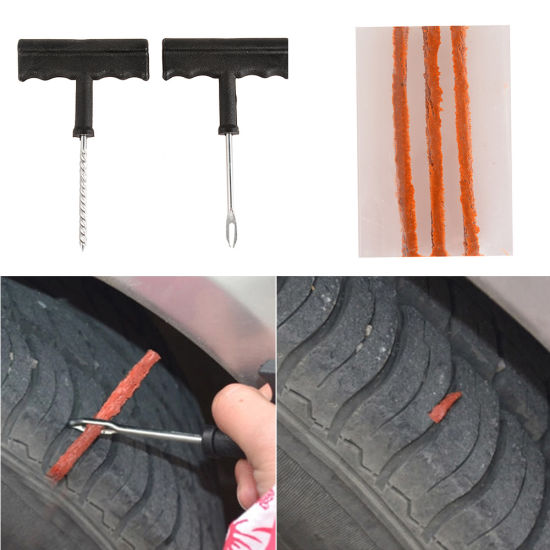 For this reason, many consumers consider a string plug repair a permanent solution. The tire manufacturing industry expressly disagrees. Various industry publications state that the greatest potential danger caused by a string plug repair is that this type of repair allows air and moisture to penetrate the body of the tire. The tire industry maintains that these elements seep in between the layers of the tire allowing the steel belts to degrade and causing the tire to deteriorate and corrode from within. Over time, this corrosion weakens the steel belts and the bonds between the rubber-to-rubber layers and rubber-to-the-wire layers of the tire, greatly increasing the risk of a tread separation. An additional risk of performing a string plug repair is that a puncture, even if it is within the “repairable” area of the tire, may cause damage to the inside of the tires. Without inspecting the inside of the tire, it is impossible to determine whether any damage has occurred, requiring it to be scrapped.
For this reason, many consumers consider a string plug repair a permanent solution. The tire manufacturing industry expressly disagrees. Various industry publications state that the greatest potential danger caused by a string plug repair is that this type of repair allows air and moisture to penetrate the body of the tire. The tire industry maintains that these elements seep in between the layers of the tire allowing the steel belts to degrade and causing the tire to deteriorate and corrode from within. Over time, this corrosion weakens the steel belts and the bonds between the rubber-to-rubber layers and rubber-to-the-wire layers of the tire, greatly increasing the risk of a tread separation. An additional risk of performing a string plug repair is that a puncture, even if it is within the “repairable” area of the tire, may cause damage to the inside of the tires. Without inspecting the inside of the tire, it is impossible to determine whether any damage has occurred, requiring it to be scrapped.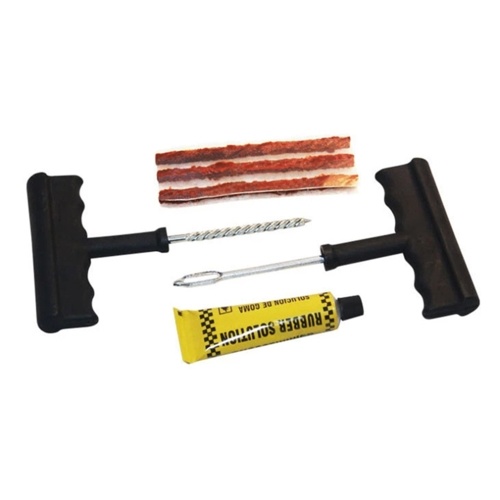
The second common tire repair method is a “patch-only” repair. In order t patch a tire, the technician must remove it from the rim to locate the puncture from the inside of the tire. After the puncture has been located, the area surrounding the puncture on the inside of the tire is prepared with scrapers, buffing tools and cleaning solutions in order to prepare the area to “bond” with the repair unit or patch. After preparation, vulcanizing cement is then applied to the patch and inner liner of the tire and the patch is applied over the puncture hole. The patch and surrounding area is stitched or rolled, and may be covered with sealant before the tire is put back on the rim. The tire industry also considers this repair method to be improper because it may allow air and moisture to seep into the tire through the injury channel from the tread surface.
It is NHTSA’s position that a combination repair is the only way to properly repair a tire puncture. A combination repair consists of a repair patch with a rubber plug/stem attached to its center. There are some rare circumstances when a separate patch and plug can be used, but normally the industry guidelines recommend a combination repair unit that is only one piece. After a puncture is located, it is reamed out to create a clean hole for the plug. The area around the puncture on the inside of the tire is then prepared to bond with the patch. Vulcanizing cement is applied to that area and to the patch/plug combination. The plug is pulled from the outside of the tire through the reamed hole so that it completely fills the hole and created a tight seal with the rubber of the tire. The patch bonds to the inside of the tire, preventing air from escaping with the plug seals the puncture hole preventing air form escaping while the plug seals the puncture hole preventing air and moisture from invading the tire. The rubber stem is trimmed to be even with the surrounding tread.
There are some rare circumstances when a separate patch and plug can be used, but normally the industry guidelines recommend a combination repair unit that is only one piece. After a puncture is located, it is reamed out to create a clean hole for the plug. The area around the puncture on the inside of the tire is then prepared to bond with the patch. Vulcanizing cement is applied to that area and to the patch/plug combination. The plug is pulled from the outside of the tire through the reamed hole so that it completely fills the hole and created a tight seal with the rubber of the tire. The patch bonds to the inside of the tire, preventing air from escaping with the plug seals the puncture hole preventing air form escaping while the plug seals the puncture hole preventing air and moisture from invading the tire. The rubber stem is trimmed to be even with the surrounding tread.
Tire Repair Litigation
The above tire repair methods have been in use for decades and litigation involving the failure of repaired tires is not new, nor is it particularly widespread.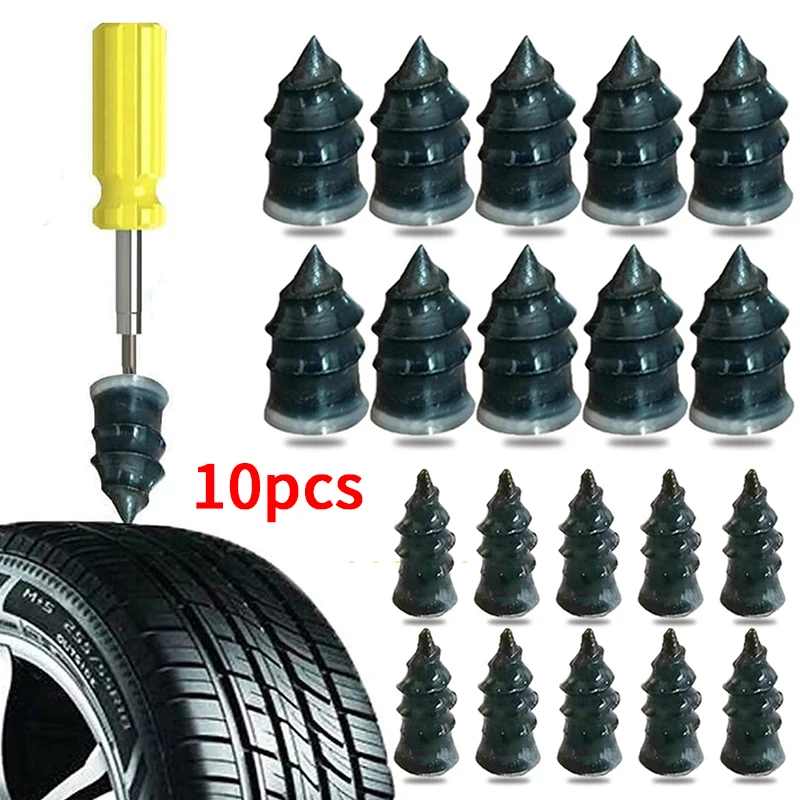 In fact, tire manufacturers will use “improper repair” as one of their primary defenses in litigation. Most recently, in October of 2011, a state court jury in Tampa, Florida awarded $13.64 million to Gwen and Roy Chattelle after they suffered a tire failure and crash at highway speed that rendered her a quadriplegic. The case went to trial against the service center and its employee, who inspected and improperly repaired a tire before the crash.
In fact, tire manufacturers will use “improper repair” as one of their primary defenses in litigation. Most recently, in October of 2011, a state court jury in Tampa, Florida awarded $13.64 million to Gwen and Roy Chattelle after they suffered a tire failure and crash at highway speed that rendered her a quadriplegic. The case went to trial against the service center and its employee, who inspected and improperly repaired a tire before the crash.
Three months prior to the crash, the Catelli’s right rear tire was low on air and was inspected and repaired by Tampa Auto Repair. There was no evidence introduced showing that the right rear tire had been moved, replaced or repaired again between the time of the repair and the time of the crash. At the time of the crash, the tire experienced a partial tread separation, suffered a catastrophic loss of air pressure and as a result, the vehicle went out of control rolled over several times. Inspection of the failed tire showed that it had two punctures.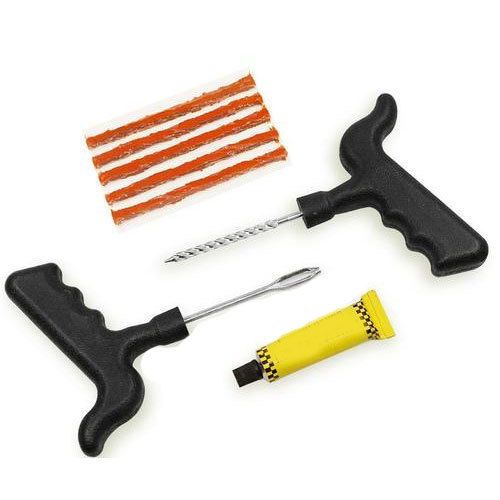 The first puncture had been repaired with an improper string plug and was already in the tire. Plaintiffs contended that the second puncture was an additional improper repair by the defendants that never properly bonded and, as a result, the repair unit became dislodged. Plaintiffs’ experts opined that the Defendants violated industry standards and their own internal policies requiring a tire with an existing improper repair to be removed from service rather than repaired. Destructive testing showed rust on the second puncture and evidence verifying the corrosion of the belts from exposure to air and moisture. The jury returned a verdict for the plaintiffs, finding that the repair shop and its manager were liable for the Plaintiff’s damages. In march 2011, a jury in San Diego County, California awarded almost 14.5 million to the minor sons of Casey and Melanie barber who were killed in a 2006 Accident in which their van rolled over. At the time of the accident, the Barbers’ children were 3, 5 and 8 years old.
The first puncture had been repaired with an improper string plug and was already in the tire. Plaintiffs contended that the second puncture was an additional improper repair by the defendants that never properly bonded and, as a result, the repair unit became dislodged. Plaintiffs’ experts opined that the Defendants violated industry standards and their own internal policies requiring a tire with an existing improper repair to be removed from service rather than repaired. Destructive testing showed rust on the second puncture and evidence verifying the corrosion of the belts from exposure to air and moisture. The jury returned a verdict for the plaintiffs, finding that the repair shop and its manager were liable for the Plaintiff’s damages. In march 2011, a jury in San Diego County, California awarded almost 14.5 million to the minor sons of Casey and Melanie barber who were killed in a 2006 Accident in which their van rolled over. At the time of the accident, the Barbers’ children were 3, 5 and 8 years old. The Barber case went to trial against a dealership that had repaired the tire using “patch-only” repair method described above. Additionally the puncture in the Barber’s tire was outside the reparable are recognized by the tire industry and evidence was presented at trial that the mechanic failed to prepare the area around the puncture to bond with the patch. Evidence was introduced that the tire mechanic who performed the repair had been on the job for less than a week and the shop had provided him with no how to properly repair a tire.
The Barber case went to trial against a dealership that had repaired the tire using “patch-only” repair method described above. Additionally the puncture in the Barber’s tire was outside the reparable are recognized by the tire industry and evidence was presented at trial that the mechanic failed to prepare the area around the puncture to bond with the patch. Evidence was introduced that the tire mechanic who performed the repair had been on the job for less than a week and the shop had provided him with no how to properly repair a tire.
This highlights the fact that consumers are unacquainted with proper tire repair methods and assume they can rely on “professional” tire repair facilities to employ mechanics with the training necessary to complete repairs properly. These recent cases emphasize the need for minimum training requirements for persons authorized to perform tire repairs. There is currently no Automotive Service Excellence certification for tire repair.
In 2006, a minor child in Florida was injured when the vehicle he was riding in experienced a tire blow out and crashed.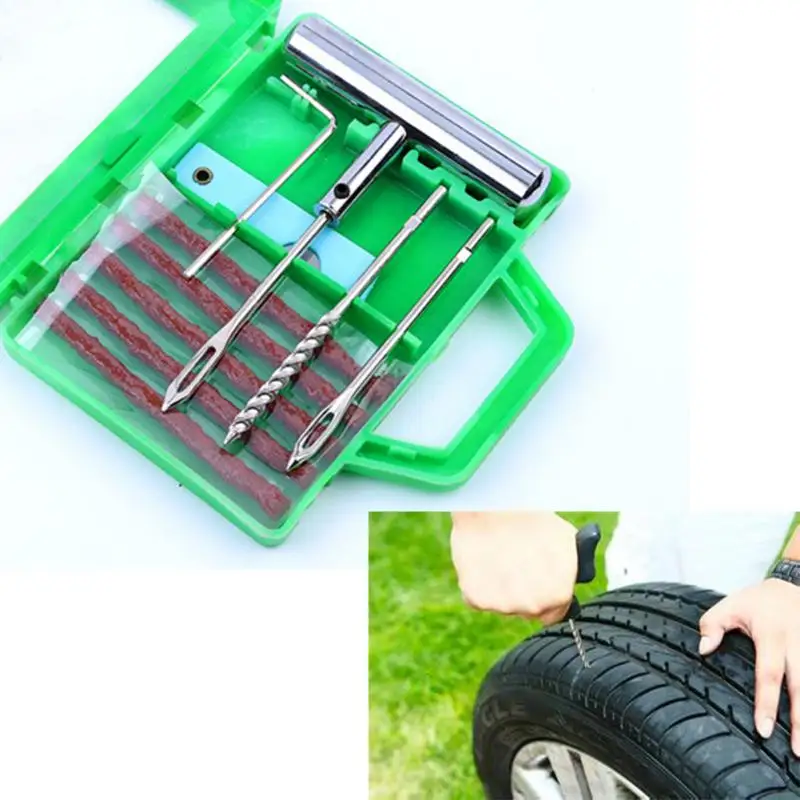 The tire had been repaired at a service station with a string plug, but no patch. The Plaintiff sued the manufacturers of the string plugs, claiming that plug only repairs are unsafe and unreliable and can lead to tire failure. The trial court granted summary judgment to the plug manufactures, ruling the plugs were not defective in and of themselves because both sides’ experts testified that they could be used safely in combination with a patch. The court of appeals reversed holding that even if a string plug was not defective in all situations, such as when used in combination with a tire patch, the jury could have found that the string plugs failed to perform as safely as a reasonable consumer would expect under Florida’s “consumer expectation” standard in product defect cases.
The tire had been repaired at a service station with a string plug, but no patch. The Plaintiff sued the manufacturers of the string plugs, claiming that plug only repairs are unsafe and unreliable and can lead to tire failure. The trial court granted summary judgment to the plug manufactures, ruling the plugs were not defective in and of themselves because both sides’ experts testified that they could be used safely in combination with a patch. The court of appeals reversed holding that even if a string plug was not defective in all situations, such as when used in combination with a tire patch, the jury could have found that the string plugs failed to perform as safely as a reasonable consumer would expect under Florida’s “consumer expectation” standard in product defect cases.
In 1996, in Peterson V. Ress Enterprises, a Chicago jury awarded $12.65 million to the Plaintiff. Peterson was a college student who was rendered quadriplegic in an accident resulting from a tire failure.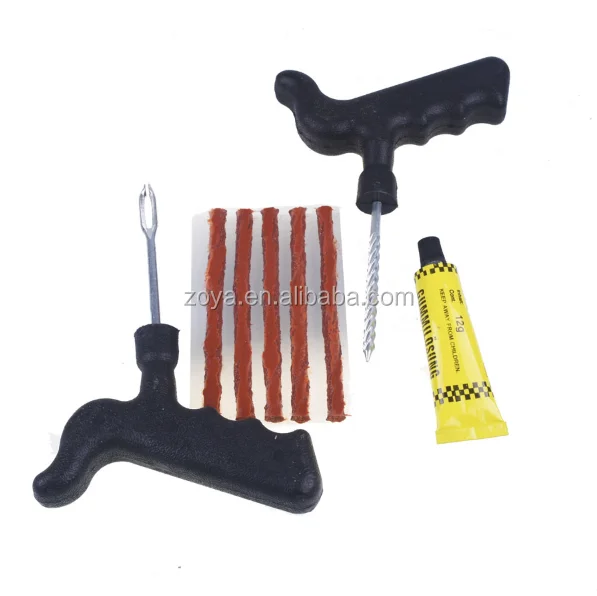 The Plaintiff contended that the accident tire was improperly repaired by the defendants using a plug-only repair five months before the crash. On appeal, the appellate court affirmed the judgment in favor of the Plaintiff. The appellate court’s summation of the expert testimony in instructive about how string plug repairs can lead to tire failure:
The Plaintiff contended that the accident tire was improperly repaired by the defendants using a plug-only repair five months before the crash. On appeal, the appellate court affirmed the judgment in favor of the Plaintiff. The appellate court’s summation of the expert testimony in instructive about how string plug repairs can lead to tire failure:
Plaintiff’s expert testified that the tire failed upon road hazard impact because it was improperly repaired for a puncture with a string plug, causing air to seep into the tire’s casing. Goodyear’s expert testified that he failed tire was weakened prior to the accident by air seepage and migration resulting from Ress’ string repair.
Goodyear’s other tire expert testified that tire failures result from string plug repairs and that a string plug without a patch does not effectively seal a tire’s inner liner and air can seep into a tire’s carcass. Goodyear’s expert further testified that tread separation affects belt strength and renders a tire less capable of traversing road hazards.
Despite widespread knowledge among such industry experts that string plug repairs are unsafe; this knowledge does not appear to be shared by the public. One challenge for plaintiffs in prosecuting a tire repair case is that many jurors have preconceived opinion that patch-only and plug-only repairs are safe and effective. Due to the lack of knowledge, many consumers believe these repairs are proper. These misconceptions are buttressed by the fact that improper can last years without failure. As a result, any juror seated in a tire repair case will likely have either personal experience with plug-only or patch-only repairs that perform without incident. Potential jurors will also hear a long string of anecdotes from other potential jurors who used these improper repairs without incident.
A second challenge, which was highlighted by the Peterson case, is that most failed tires have been in service for some period of time and show signs of some form of abuse or misuse, such as road hazards, under-inflation or overloading.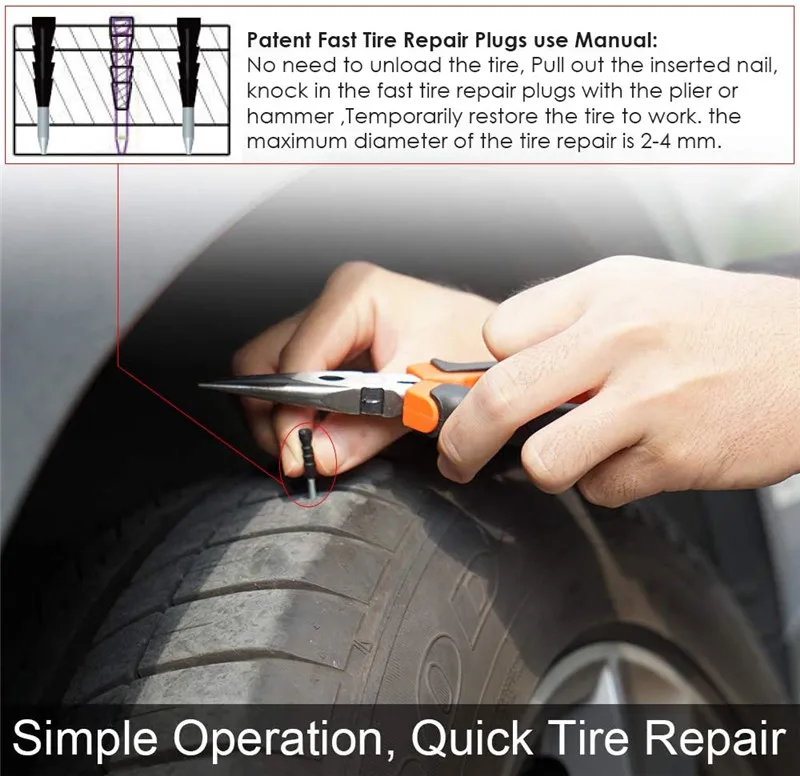 These conditions, which may or may not have contributed to the tire’s failure, create challenges in proving causation. They certainly result in ready-made defense for defendant tire manufactures. Oftentimes, multiple causes will come together, such as in Peterson, where the collective trial experts opined that the immediate precipitation event was an impact with an unknown road hazard. However, the collective Peterson experts reasoned that the tire was unable to withstand a road-hazard impact because it was already weakened by internal deterioration from the string plug.
These conditions, which may or may not have contributed to the tire’s failure, create challenges in proving causation. They certainly result in ready-made defense for defendant tire manufactures. Oftentimes, multiple causes will come together, such as in Peterson, where the collective trial experts opined that the immediate precipitation event was an impact with an unknown road hazard. However, the collective Peterson experts reasoned that the tire was unable to withstand a road-hazard impact because it was already weakened by internal deterioration from the string plug.
Why the use of Improper Repairs Persists Despite Clear Warnings
Despite the difference of a few dollars in cost between an unsafe, improper repair and a safe combination repair, widespread use of these improper repairs persists. Several factors contribute to this continued popularity of improper repair techniques. First, because plug-only repairs are performed from the outside of the tire and do not require demounting the tire from the rim, a plug-only repair can performed by almost anyone, anytime and with nothing more than an inexpensive repair kit.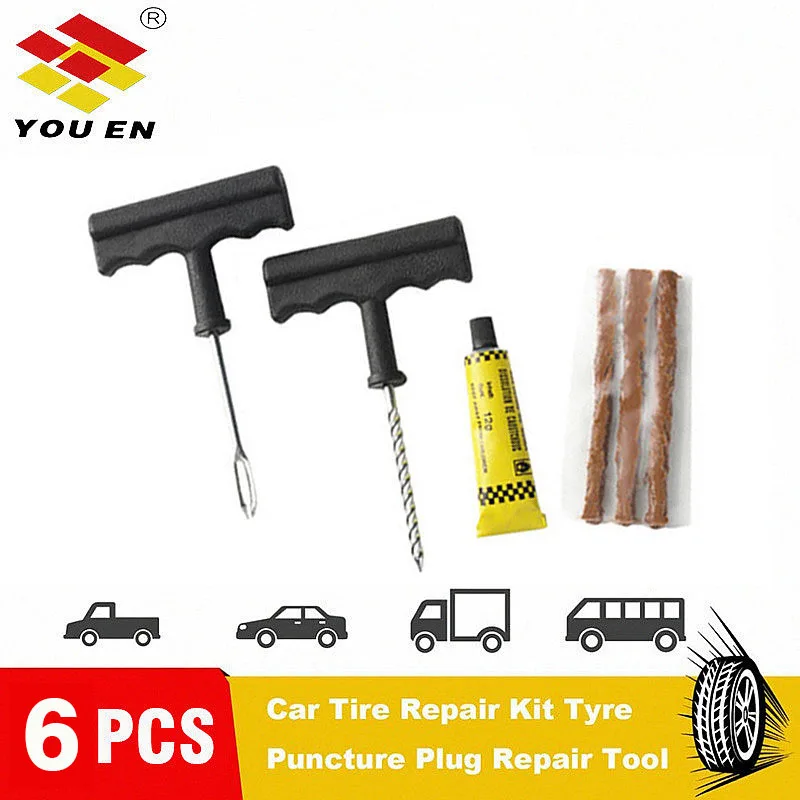 It is a relatively simple process that does not require the multiple steps necessary for a proper repair, like demounting, sanding or buffing, nor are adhesives required, making these repairs faster and less expensive. For most people it means the difference between being able to “do it yourself” at your own convenience, and having to leave your vehicle at a repair shop to be fixed on someone else’s schedule.
It is a relatively simple process that does not require the multiple steps necessary for a proper repair, like demounting, sanding or buffing, nor are adhesives required, making these repairs faster and less expensive. For most people it means the difference between being able to “do it yourself” at your own convenience, and having to leave your vehicle at a repair shop to be fixed on someone else’s schedule.
Secondly, problems caused by plug-only repairs may not happen immediately and, therefore, even if the tire does eventually fail, people may not associate that failure with the repair that occurred months or years earlier.
Additionally, many tire mechanics are never trained with proper techniques and many have used string plugs for years, resulting in a comfort level with the product. Many tire repair shop policies actually encourage the use of this method. Past testimony indicates that some shops are unaware or unconcerned with the safety issues caused by plug-only repairs. Other shops yield to the wishes of consumers who may insist the mechanic perform a plug-only repair that may save money. Still other cases show that some repair facilities actually train their mechanics to use plug-only repairs and supply the shop with the tools to do so. However, even shops those “officially discourage or prohibit the use of string plugs often employ a pricing and wage structure that creates a strong incentive for its workers to use them anyway.
Other shops yield to the wishes of consumers who may insist the mechanic perform a plug-only repair that may save money. Still other cases show that some repair facilities actually train their mechanics to use plug-only repairs and supply the shop with the tools to do so. However, even shops those “officially discourage or prohibit the use of string plugs often employ a pricing and wage structure that creates a strong incentive for its workers to use them anyway.
After reporting the out come of Barber case discussed above, one automotive repair websites received scores of comments critical of the litigious Americans” who had field lawsuits related to plug-only repairs. One commentator, apparently a mechanic at a facility that repairs tires said “We were told to patch, but I buy my own plugs … a patch pays 0.3 a plug pays 0.3” In other words, most repair facilities compensate mechanics by the type of job, assigning a specific amount of time to complete it. If a tire, it will usually take longer that the time allotted to perform a combination repair.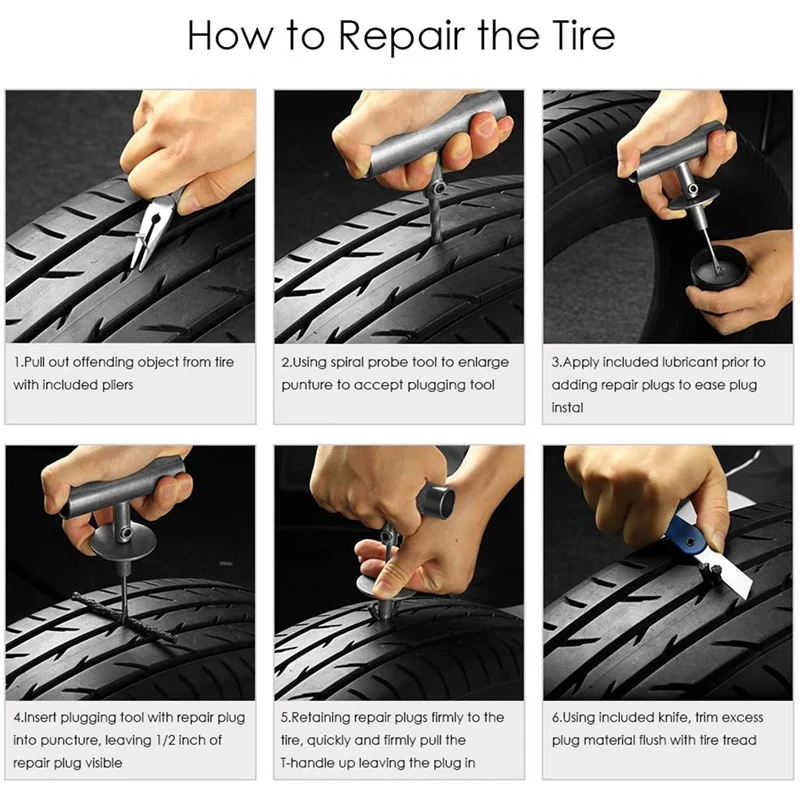 These results in a incentive for the mechanic to use the quicker, less effective repair method to save time, make more money and move on to the next job.
These results in a incentive for the mechanic to use the quicker, less effective repair method to save time, make more money and move on to the next job.
Finally, consumers are unacquainted with the long term dangers of driving on tires with improper repairs. There are strong public sentiment that our government is overly active in recalling and banning unsafe products, so it is reasonable for consumers to assume that if string plug repair kits are being offered for sale legally at reputable retailers and tire repair shops, they must be safe. A cursory review of multiple automotive websites reveals the widely revels the widely held belief that if a string plug holds air, it is safe to use. Some consumers buy “emergency tire repairs kits” just to get them through a roadside emergency, but then forget to replace the tire. Consumers may also assume that if the tire is holding air, the string plug is “working” without realize that it is causing the tire to slowly deteriorate from the inside.
Country of origin: Russia
Description
Description Characteristics Availability
Description
Description
Applicable:
VAZ 2121
Characteristics
Characteristics
Availability
0003
Store address
Opening hours
Availability
Volgogradskaya street, 105
from 8:00 to 19:00
Availability:
Not available nine0003
Sukhumi highway, 110A
from 8:00 to 19:00
Availability:
Not available
from 8:00 to 20:00
Availability: nine0003
Not available
Volgogradskaya street, 99
from 8:00 to 19:00
nine0035 Availability:Not available
360 ₽
Add to cart 8 pcs. nine0003
nine0003
Code: 000062513
Stock 8 pcs.
Set of bottom plugs VAZ 2121
Add to cart AllAcuraAudiBMWChevroletChryslerCitroenDislaDodgeFiatFordHondaHyundaiJaguarJeepKiaKormetalLand RoverLexusMazdaMercedesMiniMitsubishiNissanOpelPeugeotPorscheRange RoverRenaultSeatSkodaSubaruSuzukiTeslaToyotaUniversalVolkswagenVolvoCover 9002 9000 All4549Mold All4243444647484949.5505151.55252.5535454.55555.5565757.55858.55960616263646565.567707380102117125133
Color AllBlackRedSilverSilver+Black LogoSilverGrayBlueChromeBlackBlack+CarbonGloss Black
VseGogolya
Buying car tires, rims and accessories online saves time and money, being the easiest and most convenient way to achieve excellent search results. Seasonal tire replacement, tuning, improving the appearance of a car due to original parts, elements and accessories - all this can easily be done by our online store. nine0003
It is convenient to choose caps for alloy and steel wheels of different manufacturers and price categories on the site.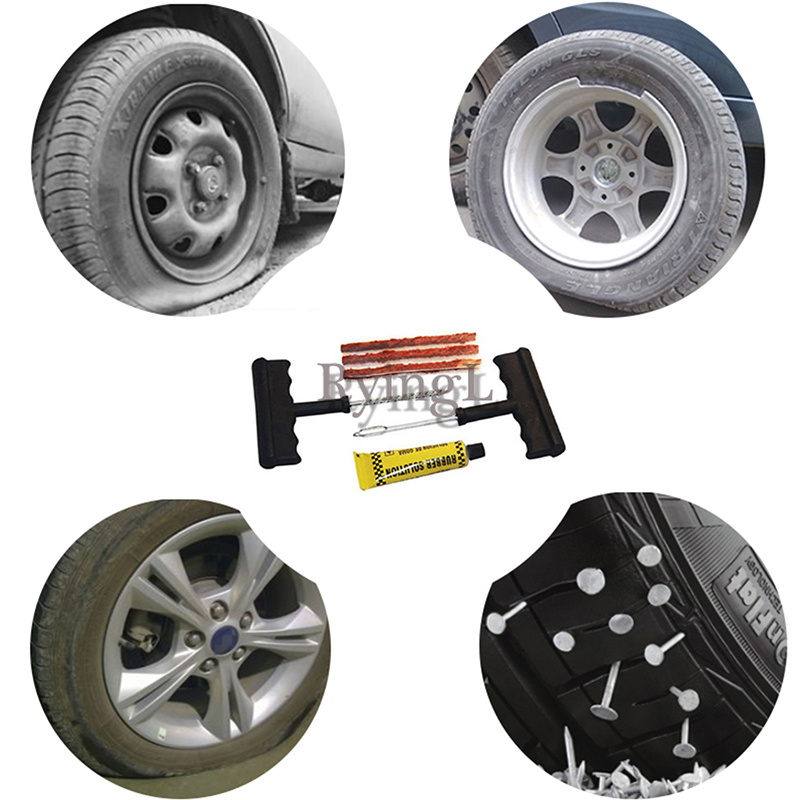 An extensive catalog of commodity items will help you choose and buy stubs for discs (nameplates) on cars of different brands. Affordable prices, different sizes, caps for wheels to order, pickup from the Dnieper or delivery to any other city in Ukraine - all this will help to minimize efforts and equip your car with high-quality and stylish hub caps. nine0003
An extensive catalog of commodity items will help you choose and buy stubs for discs (nameplates) on cars of different brands. Affordable prices, different sizes, caps for wheels to order, pickup from the Dnieper or delivery to any other city in Ukraine - all this will help to minimize efforts and equip your car with high-quality and stylish hub caps. nine0003
Hub cap or wheel hub cap differs in appearance, design, material used for manufacturing. It can be plastic, aluminum or other metal. When choosing, you should also take into account important parameters - diameter, radius. Thanks to the extensive range, the purchase process will be quick and comfortable. Car owners will be able to select and order a set of plugs for wheels of the required parameters, spending a minimum of time on this.
Wheel hub caps are one of the most popular types of car accessories. They mask various defects, chips and cracks, giving the car a stylish and presentable look. Wheel bolt caps will hide a rusty bolt, hub caps with a logo will become an element of tuning. You can buy caps in the R20 online store, which offers a wide selection of quality products at affordable prices.
Wheel bolt caps will hide a rusty bolt, hub caps with a logo will become an element of tuning. You can buy caps in the R20 online store, which offers a wide selection of quality products at affordable prices.
Using the site is convenient:
Wheel caps for alloy wheels perform several functions, the main of which is aesthetic: wheels with caps look more stylish and impressive. Plastic, coated, in the form of a star, universal or exclusive, with the logo of the car manufacturer in the center - the choice depends on the preferences of each car owner. It remains to determine the requirements and find where to buy plastic caps for cast (titanium, aluminum) or stamped (steel) wheels will be profitable. Thanks to the huge number of options presented in the catalog, it has become easy to decorate your car with stylish accessories. nine0003
nine0003
When choosing caps, you should pay attention to important parameters, among which are the outer and inner diameters, as well as the seating depth - the length of the fastening tabs in mm. The radius of the disk does not matter. All these measurements are indicated on the website, where visual photos are also presented. The selection of caps by car brand is undesirable, since the same cars are equipped with different disks, for which plugs of different sizes are suitable. The R20 online store will help you purchase quality products that have received good reviews. nine0003
Fitting and outer diameters of the central hole (CO), original number, factory parameters, symbols - nuances that must be taken into account. To install decorative plugs, a minimum of effort is required: the covers are equipped with special latches (clips) with which they can be easily fixed. The caps are made of impact-resistant plastic, on which the logo of the car brand is applied.